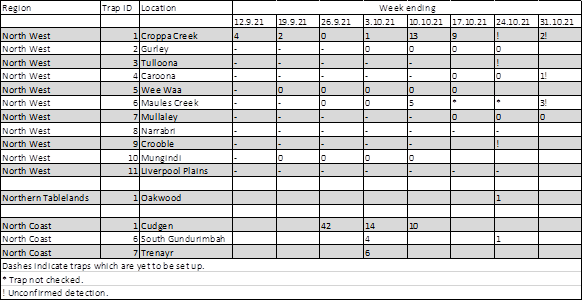Fall armyworm update in NSW (Oct 2021)
Fall armyworm (Spodoptera frugiperda) is an insect pest that was first detected in NSW in 2020.
This insect pest is a serious threat to a wide range of industries including grain, rice, cotton, vegetables and sugarcane.
The detections were a result of a joint NSW Department of Primary Industries (NSW DPI) and Local Land Services initiative to establish an early warning trapping network in response to the threat of fall armyworm. These traps were established in Autumn 2020.
A Fall Armyworm trap network is being established for the current Summer crop season across NSW, with some early detections in the Northern part of the state. These populations will be monitored and detections reported as they come to light across the state. With the current cooler than normal temperatures, the growth and spread of fall armyworm populations into the southern region is expected to be slow.
The key message for Growers and Advisors is to be alert but not alarmed with fall armyworm populations. Monitoring and early control are key to successfully managing fall armyworm this season.
Update as of 25 October 2021
Latest fall armyworm trapping results from the North West region in the week ending October 22nd are provided in the table below.
Detections were confirmed in the Croppa Creek and Maules Creek areas last week.

Growers are urged to conduct regular checking in susceptible crops for signs of larval activity and feeding damage.
The best option for identification of larvae is to send clear photos (head and tail ends) to the email address: fallarmyworm@dpi.nsw.gov.au
Larger larvae are easier to identify. To assist identification, please retain and rear small larvae on a suitable food source (host crop leaves) until they are larger than 25mm before sending images.
Top Tips for Management of Fall Armyworm
1. Know if the pest is in your area
Moth surveillance is an important first action in management because it alerts growers the presence of local fall armyworm activity.
2. Follow up with regular in-crop monitoring for larvae and signs of damage
If in doubt about which species of larvae is in your crop, send clear images of the head and tail to: fallarmyworm@dpi.nsw.gov.au
3. Optimise control costs by timely application of selective insecticides on above threshold populations
If sprays are warranted, act fast with full-rates of insecticide to target small larvae before they establish in whorls of plants, at which point control will be more difficult to achieve.
4. Approach control with an IPM focus and take advantage of natural enemies present in crops
Make spray decisions that will conserve beneficial insects which help to suppress fall armyworm populations in your crop as part of an IPM strategy.
5. Know which chemicals are likely to be MOST effective on fall armyworm
Selective insecticides such spinosyns (Group 5, e.g. Entrust®, SuccessNeo®), emamectin benzoate (Group 6, e.g. Affirm®, Proclaim®) and chlorantraniliprole (Group 28, e.g. Altacor®, Coragen®) are likely to provide effective control if used correctly.
6. Know which chemicals are NOT effective on fall armyworm
Fall armyworm has high levels of resistance to synthetic pyrethroids such as alpha-cypermethrin and growers are advised to avoid these products because they will not control of FAW and they will destroy crop beneficials.
7. Be mindful of the effect your insecticide sprays could be having on other pests in the crop
Overuse of selective insecticides will increase resistance levels in fall armyworm and Helicoverpa armigera. Use a planned approach to insecticide selection and chemical rotation in maize and sorghum to minimise resistance risk.
8. Further information on fall armyworm identification, treatment options and resistance management is available at:
https://www.dpi.nsw.gov.au/biosecurity/plant/insect-pests-and-plant-diseases/fall-armyworm
Contact
Lisa Bird (0438 623 906, lisa.bird@dpi.nsw.gov.au).
A full list of notifiable plant pests and diseases can be found in Schedule 2 of the NSW Biosecurity Act 2015.
Resources
- Chemical management options
- Primefact: Fall armyworm
- Poster: Fall armyworm
- Poster: Identifying Fall armyworm
- Queensland government information on fall armyworm
- The Beatsheet - Fall armyworm, should you be concerned?
- Australian Government information on fall armyworm
- Cotton Info fall armyworm identification guide.
- Fall armyworm – ID, modelling predictions, control and management strategies - YouTube
- Fall armyworm (nsw.gov.au)
Disclaimer: The contents of this article are a general guide only, not comprehensive or specific technical advice. Circumstances vary from farm to farm. To the fullest extent permitted by law, NSWDPI expressly disclaims all liability for any loss or damage arising from reliance upon any information, statement or opinion in this presentation or from any errors or omissions in this document. The product trade names in this publication are supplied as examples on the understanding that no preference between equivalent products is intended and that the inclusion of a product does not imply endorsement by NSWDPI over any other equivalent product from another manufacturer. Any information regarding pesticides or their use in this publication does not constitute a recommendation for that particular use by the authors or the author’s organisations. All pesticide applications must accord with the currently registered label or permit for that particular pesticide, crop, pest and region.